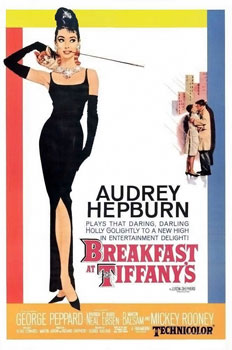
Breakfast at Tiffany’s, 1961
This is an image of the original theatrical release poster of an iconic film of the 60’s, Breakfast at Tiffany’s. The poster was meant to serve as an advertisement for the movie, both which were released in October of 1961. The image features the alluring main star, Audrey Hepburn, dressed in her classic black dress accessorized with diamonds galore. Her long cigarette holder dangles from her lips to complete the look. Simply analyzing her outfit points out multiple ideals of the 60’s- some of which second wave feminists were trying to change in their long fight against inequality.
The image was a scanned copy of the original poster. One of these posters sold in mint condition can cost up to $10,000! Often, you can find this poster zoomed in just to depict Audrey Hepburn. The outfit is immensely prominent in both the film industry and current popular culture. Now a JPG found anywhere on the internet, this specific poster originated from Paramount Pictures movie studios. Paramount is the longest operating studio in American history, a arguably the most famous. Therefore, in 1961 when this image was released, it would have been seen by most of the general public, especially with Audrey Hepburn’s growing prominence in Hollywood and with the huge success of the movie. Classic 1960’s art was used to create this poster. The bright colors, the thick, square boarders, and the white background easily catches the eye of anyone walking by. “Technicolor” is mentioned at the bottom, comparing the film to other traditionally black and white or dull colored movies. “AUDREY HEPBURN” is loudly slammed in the center. This creates an illusion that the movie is female centered with a strong female actress, which would capture the attention of any feminist. In the corner, you see a couple kissing- an image that evokes the happiness that usually accompanies the sight of two people in love. The iconic “kissing in the rain” scene created by romantics of the film industry is also recognized. Overall, looking at this poster in the 1960’s would make one feel excited, proud, and giddy.
As much as one can talk about the other scenes on the poster, little can argue that Audrey Hepburn in her famous outfit isn’t the most captivating part. According to Wikipedia, “Little Black Dress” by Givenchy, worn by Hepburn in the beginning of the film, is cited as one of the most iconic items of clothing in the history of the twentieth century and is, perhaps, the most famous little black dress of all time”. to have been sold for $947,000. The dress is practically perfect- sexy but not too reveling, tight around the hips, and extenuates her breasts. Her diamonds sparkle almost as much as her mysterious eyes, her cigarette holder adds just the right amount of dangerousness- what man could resist? It is clear to see simply from this poster that Audrey, or “Holly”, her name in the film, was being sexualized in every possible manner. Even though Audrey was cast in a female centric film, her part is almost entirely about pleasing men. In the 1960’s, second wave feminists were trying to change the stigma that women weren’t anything less than sex objects that clean their husbands house. The Breakfast at Tiffany’s Poster, although highlighting that a women is playing a lead part, is a perfect example of how women are still used in the film industry as alluring objects that need men to pick up their broken pieces. Judith Butler in her essay on Gender Trouble states,“ Gender emerges as the congealed form of the sexualization of inequality between men and women”. Judith is explaining that when famous figure such as Audrey Hepburn is sexualized on television, it allows the gender gap to widen between men and women as unequals. Film’s that are so influential to popular culture and can easily affect gender and cultural schema’s prominent in the time period, and the outreach of those affects can reach our present day culture. Audrey Hepburn in Breakfast at Tiffany’s continues to be an iconic image that impacts the way people view woman as sexual figures, even in present day.
https://en.wikipedia.org/wiki/Breakfast_at_Tiffany%27s_(film))
https://www.fashiongonerogue.com/audrey-hepburn-breakfast-tiffanys-costume-style/